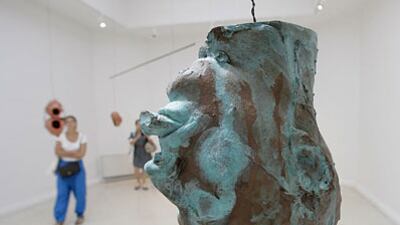When asked what most impressed him at the Venice Biennale last week, mega-art-collector and Interview publisher Peter Brant quickly replied, “From Hand to Mouth,” while pointing to the US Pavilion. The shorthand reference to Bruce Nauman’s Biennale exhibition, Topological Gardens, was taken from the title of one of Nauman’s earliest work on view in the show—a 1967 sculpture of a fragmented hand, arm, shoulder, and mouth. The seminal piece, made from wax and cloth, references the simple act of eating and serves as the perfect introduction to Nauman’s lifelong engagement of interpersonal communication, rituals, and mundane situations.
CLICK IMAGE BELOW TO VIEW OUR GALLERY OF NAUMAN’S CAREER RETROSPECTIVE

CLICK IMAGE BELOW TO VIEW OUR GALLERY OF TOPOLOGICAL GARDENS

Hardly a household name—though few conceptual artists are—Nauman made international headlines this week after winning the Golden Lion Award at the 53rd Venice Biennale. It’s not Nauman’s first Golden Lion; the 67-year artist received one in 1999 for lifetime achievement, but this time around it’s the big prize, the award for best national participation. The exhibition, which takes place in the US Pavilion in the Giardini and at two local universities, features 33 works from the past 42 years in a variety of media.
Organized by Philadelphia Museum of Art curators Carlos Basualdo and Michael Taylor, the show was kept a secret for many months, but by the second day of the press previews, it was starting to get a lot of Biennale buzz. Three themes define the exhibition—Heads and Hands, Sound and Space, and Fountains and Neons—and these threads run through each venue. By having the work spread throughout the city, which is the first time a national pavilion at Giardini has had additional venues, the viewer is forced to traverse and negotiate Venice. Arguably, the best works are in the US Pavilion, but the sister sites allow for other subversive things to happen.
Another key work in the pavilion is The True Artist Helps Make the World by Revealing Mystic Truths (Window or Wall Sign). The spiraling neon sign, which occupied the street window of Nauman’s storefront studio in the ‘60s and expresses the artist’s philosophical belief, can now be seen in a rear window the pavilion that was previously covered. Elsewhere, the addition of a window in the front of the building allows the passerby to view two fountains pieces, pumping water through suspended, resin cast heads.
The installation Fifteen Pairs of Hands places 15 white bronze sculptures of dismembered hands in ordinary and witty poses on painted steel bases in the pavilion’s main room and dual-channel video Washing Hands Normal shows a pair of stacked monitors simply screening a man’s hands washing one another under water. Meanwhile, a video monitor, showing a fox being skinned, is displayed with four foam animal bodies, normally used by taxidermists, in the bizarre and disturbing Hanging Carousel (George Skins a Fox).
Over at Università Iuav di Venezia at Tolentini in Santa Croce, Nauman powerfully lit a long corridor with pink and yellow Fluorescent lights for an experimental, minimal installation from 1972 and turned another corridor into a sound piece Days, in which different voices recorded in several American cities repeatedly speak the days of the week; and Think offers stacked monitors showing Nauman’s head upside down and right side up, endlessly shouting the word think!
The Exhibition Spaces at Università Ca’ Foscari, a 15th-century gothic palace, hosts Double Steel Cage Piece, which consists of a cage within a cage that has a corridor between them that’s just big enough to uncomfortably squeeze around the parameter; an Italian version of the Days sound installation, titled Giorni and recorded with the help of local students; and a pair of giant plaster smoke rings, resting on wood slats on the floor, among other pieces.
The Days/Giorni sound installations are Nauman’s newest works, and were specially made for Venice. The artist recently told the New York Times’ Carol Vogel, “I was having a hard time working, but still I would go to the studio every day. Day after day I kept thinking, what am I going to do, it’s Monday, it’s Tuesday, and then I thought: Okay, I’ll do something about the days of the week.” The simple yet mesmerizing pieces will be seen in an upcoming show at the Philadelphia Museum of Art, but until then they will be speaking to Biennale visitors and students at the universities throughout the summer.
Plus: Check out Art Beast, for galleries, interviews with artists, and photos from the hottest parties.
Paul Laster is the editor of Artkrush.com, a contributing editor at Flavorpill.com and Art Asia Pacific, and a contributing writer at Time Out New York and Art in America.






